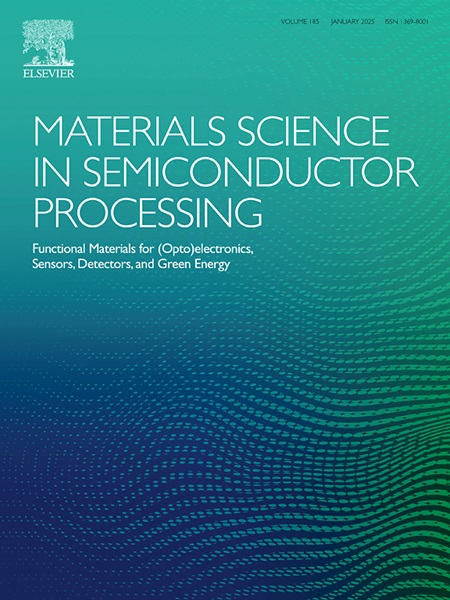纳米多孔氮化镓作为器件光学活性介质的形成时间优化和评价
IF 4.2
3区 工程技术
Q2 ENGINEERING, ELECTRICAL & ELECTRONIC
引用次数: 0
摘要
纳米多孔氮化镓(NP-GaN)嵌入亚纳米级气隙(n≈1),极大地扩展了超薄分布式布拉格反射器(DBRs)的折射率调制,增加了光电化学(PEC)反应的表面积,减轻了衬底晶格限制,使高in红光发光二极管(led)成为可能,甚至已应用于光伏电池。然而,它作为光活性介质的使用几乎没有报道,这使得对其光学和结构特性的全面评估对于更广泛的器件集成至关重要。在此,我们通过评估蚀刻时间为5至15分钟的NP-GaN样品的光学和结构特性,报告了NP-GaN作为器件光学活性介质的潜力。我们的研究结果表明,当蚀刻时间超过10分钟时,由于ga相关副产物的孔壁钝化,平均孔径不会显着增加。同时,在蚀刻10 min的NP-GaN样品中观察到最高的载流子寿命和最强的集成近带边缘(NBE)强度,这归因于孔隙分支。总的来说,10分钟的蚀刻时间是形成NP-GaN的最佳时间,从而产生了优越的光学性能。与块体薄膜相比,NP-GaN具有更高活性表面积的光学特性优势,其蚀刻持续时间的优化为各种器件应用的实现提供了见解。这不仅限于GaN,还扩展到其他氮化物,如InGaN和AlGaN,拓宽了可用的带隙范围。本文章由计算机程序翻译,如有差异,请以英文原文为准。
Formation time optimization and evaluation of nanoporous GaN as an optically active medium for device applications
Nanoporous GaN (NP-GaN) embeds sub-nanoscale air gaps (n ≈ 1) that greatly expand refractive-index modulation for ultra-thin distributed Bragg reflectors (DBRs), boost surface area for photoelectrochemical (PEC) reactions, alleviate substrate lattice constraints to enable high-In red light emitting diodes (LEDs), and have even been applied in photovoltaic cells. Yet its use as an optically active medium is scarcely reported, making comprehensive evaluation of its optical and structural properties imperative for broader device integration. Herein, we report the potential of NP-GaN as an optically active medium for device applications by evaluating the optical and structural properties of NP-GaN samples etched for durations ranging from 5 to 15 min. Our results show that the average pore diameter does not increase significantly when the etching duration exceeds 10 min due to pore wall passivation by Ga-related byproducts. Meanwhile, the highest carrier lifetime and the strongest integrated near-band edge (NBE) intensity were observed in the NP-GaN sample etched for 10 min, which was attributed to pore branching. Overall, a 10 min etching duration, resulting in superior optical properties, was optimal for the formation of NP-GaN. With its advantages in optical properties with a higher active surface area compared to bulk thin films, NP-GaN optimization of etching duration provides insight into the realization of various device applications. This is not limited to GaN but extends to other nitrides such as InGaN and AlGaN, broadening the available bandgap range.
求助全文
通过发布文献求助,成功后即可免费获取论文全文。
去求助
来源期刊

Materials Science in Semiconductor Processing
工程技术-材料科学:综合
CiteScore
8.00
自引率
4.90%
发文量
780
审稿时长
42 days
期刊介绍:
Materials Science in Semiconductor Processing provides a unique forum for the discussion of novel processing, applications and theoretical studies of functional materials and devices for (opto)electronics, sensors, detectors, biotechnology and green energy.
Each issue will aim to provide a snapshot of current insights, new achievements, breakthroughs and future trends in such diverse fields as microelectronics, energy conversion and storage, communications, biotechnology, (photo)catalysis, nano- and thin-film technology, hybrid and composite materials, chemical processing, vapor-phase deposition, device fabrication, and modelling, which are the backbone of advanced semiconductor processing and applications.
Coverage will include: advanced lithography for submicron devices; etching and related topics; ion implantation; damage evolution and related issues; plasma and thermal CVD; rapid thermal processing; advanced metallization and interconnect schemes; thin dielectric layers, oxidation; sol-gel processing; chemical bath and (electro)chemical deposition; compound semiconductor processing; new non-oxide materials and their applications; (macro)molecular and hybrid materials; molecular dynamics, ab-initio methods, Monte Carlo, etc.; new materials and processes for discrete and integrated circuits; magnetic materials and spintronics; heterostructures and quantum devices; engineering of the electrical and optical properties of semiconductors; crystal growth mechanisms; reliability, defect density, intrinsic impurities and defects.
 求助内容:
求助内容: 应助结果提醒方式:
应助结果提醒方式:


